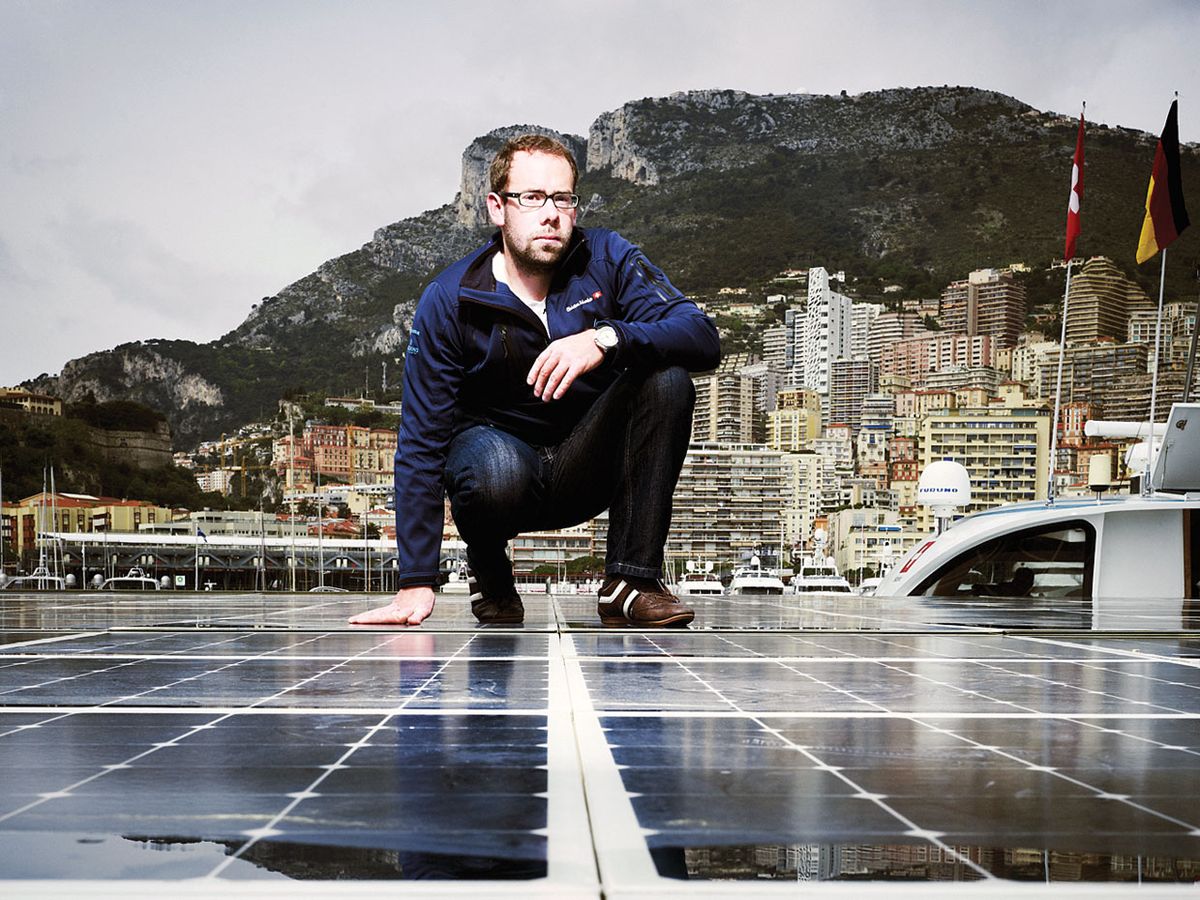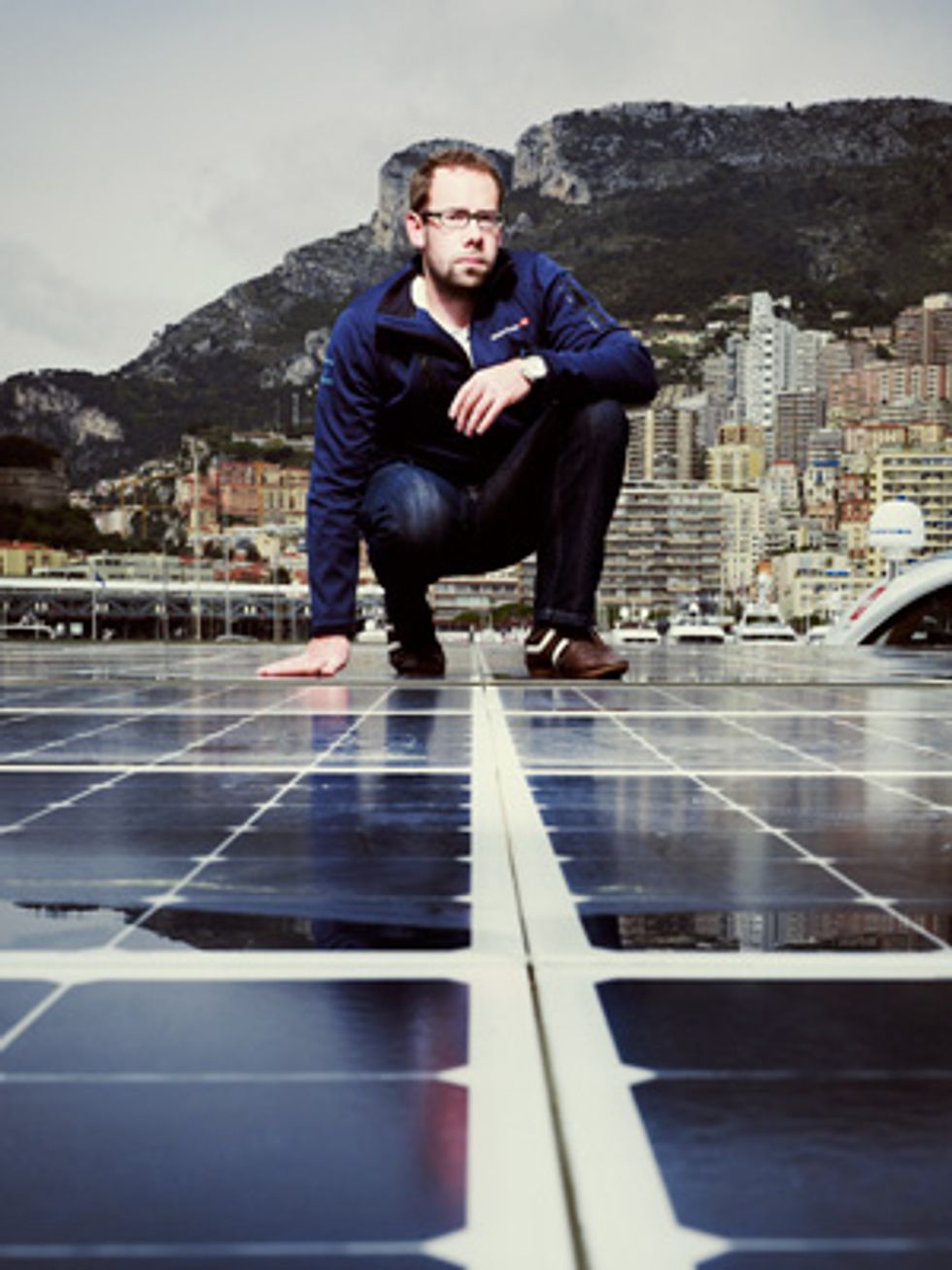PlanetSolar’s Christian Ochsenbein Sails the Seas on Sunshine
Christian Ochsenbein was the engineer on board the only solar boat to circumnavigate the globe

Inside the main cabin of MS TûranorPlanetSolar, the first boat to travel around the world on sunlight alone, Christian Ochsenbein opens a trapdoor hidden beneath a seat cushion and crawls inside. He climbs down a dark tube and squats inside a long, narrow chamber—one of two pontoons keeping the catamaran afloat.
“We are now inside the 'engine' room," he jokes. This being a solar-powered boat, there is no real engine to see. He points out the propeller shaft, driven by AC motors, and at the opposite end, a vault that houses solar-charged batteries. He can't show them off up close, he says, because they contain top-secret German submarine technology.
Ochsenbein is clearly impressed with the energy system, which had never been tested to such an extreme before the recent circumnavigation. As the vessel's onboard engineer, he got to know the system very well. It was his job to keep it from failing. Because if it had, “then the engine stops," he says. “The fridge for our food stops. We can't make fresh water. We have no lights, no navigation instruments. It's game over."
Ochsenbein is a mountain boy at heart: He grew up in the Swiss city of Thun, surrounded by the whitewashed peaks of the Alps. But he was no stranger to the water. He swam competitively, eventually winning two bronze medals in the Swiss National Championships. His father, a chief technician at a shipyard on Lake Thun, introduced him as a youngster to the pleasures of yachting.

In secondary school, he took an apprenticeship with a small electronics company, where he made parts for trains, coffee machines, and electronic locks. There, he discovered an affinity for engineering—for the transformative process of creating a product out of little more than an idea and a soldering iron.
He went on to earn a bachelor's degree in electrical engineering at Bern University of Applied Sciences and then got a job building industrial laser cutters for Bystronic Laser. But after two years at the company, uninspired by the monotony of rebuilding the same products a thousand times over, he left to find the next challenge.
It came, all right—and it was a doozy.
He'd been out of work less than a month when he got a call from a fellow Swiss engineer, an adventurer named Raphaël Domjan, who was aiming to circle the globe with a solar-powered yacht. Two years under construction at a German shipyard, PlanetSolar was just weeks from completion.
Domjan had already found a full-time boatswain and two captains who would split the voyage. Now all he needed was an electrical engineer to oversee the ship's technical systems—its 38 000 photovoltaic cells, its 11 metric tons of lithium-ion batteries, its 120-kilowatt propulsion motors, and all its converters, connectors, and switches. Ochsenbein had the right skills, and Domjan liked his easy manner and team spirit. Would he join the expedition?
Ochsenbein wasn't sure how to respond. “I had many sleepless nights," he says. He'd never before spent time at sea and worried he'd get seasick. Most troubling, though, was the thought that he'd be responsible for handling any technical problems that cropped up on the journey. “When you're thousands of kilometers from the next island, you cannot just call an electrician to bring a tool or a spare part," he says.
In the end, he took the advice his grandfather had often given him on hiking trips into the mountains—that it's better to make yourself sick trying than to regret not having tried at all. Three weeks later, he traveled to the shipyard in Kiel, Germany, where PlanetSolar was built, and climbed aboard.
The 35-meter-long boat was unlike any he'd ever seen. Perched on a pair of enormous talon-like pontoons, its massive central hull hovered above the waves. Jet-black solar panels tiled its deck and extended out over its sides, like the wings of a giant bird of prey.
“People always say that it looks like a spaceship," Ochsenbein says. Months later, he recalls, when PlanetSolar had anchored in the Marquesas Islands, smack-dab in the middle of the Pacific Ocean, a local woman told him that when she saw the ship gliding into the bay, she screamed because she thought it had come from Mars.
From Kiel, Domjan and his crew navigated PlanetSolar to Monaco, where their world tour would officially start. The shakedown voyage provided Ochsenbein with a crash course on the boat's electrical and power-control systems. Engineers from Drivetek, the Swiss company that had built the systems, were on board to show him the ropes. He paid close attention, knowing that when the real journey began, he would basically be on his own.
On 27 September 2010, the crew departed Monaco with much fanfare. They began the 19-month world tour by heading west across the Atlantic to Miami, then proceeding on to Cancún, Mexico, and Cartagena, Colombia, before passing through the Panama Canal toward the Galapágos Islands. From there, they hopped various far-flung Pacific islands to Brisbane, Australia, then zigzagged northwestward, skirting the coasts of southeast Asia, India, and the Arabian peninsula before squeezing through the Suez Canal into the mild Mediterranean Sea. From over the horizon, sunny Monaco lured them like a homing beacon.
It took Ochsenbein some time to adapt to life at sea. He woke each morning before 2 and navigated the ship for 3 hours until 5 a.m. During the day, he cooked and cleaned. He checked the motors, pumps, and other electrical systems and performed any needed maintenance. Then at 2 in the afternoon, he climbed the narrow staircase onto the bridge and took the helm again until 5 p.m.
Although he soaked in much natural beauty during the voyage, some of the things he saw on the open ocean horrified him. “I didn't do a single 3-hour watch without seeing garbage," he says. And he saw fishing trawlers scoop up sharks and dolphins in their kilometers-wide nets, oblivious to their unintended catches.
There were other discomforts. The ship had no cooling system, and the heat absorbed by the solar panels often raised the temperature inside to as high as 46 °C (115 °F). “You're sitting in a chair wearing a T-shirt and shorts and doing nothing, and you're sweating like you were running like hell," Ochsenbein remembers. The panels themselves would heat up to 85 °C, hot enough to begin melting the rubber soles of the sailors' shoes. Sometimes, during peak heat, “we put down a frying pan and made some eggs—sunny-side up."
Despite the hardships, Ochsenbein embraced solar travel. “It's a fantastic feeling just being out on the ocean for many months," he says. “It's a way of [living in] freedom." Without diesel engines or sails, PlanetSolar was so quiet he once heard a whale breathing. Sometimes on warm evenings, he would sit on one of the ship's supporting pontoons, dangling his feet in the teal water while trailing a line. “We caught a few fish," he recalls modestly—and then can't resist listing some trophies: “a big marlin and some nice tunas."
It wasn't always smooth sailing, though. While crossing the Gulf of Aden, off the Horn of Africa, the crew and six former French soldiers escorting them were on edge for four weeks, knowing that Somali pirates might try to hijack their exotic €12.5 million vessel. Three times over the course of the trip, a solar cell shattered, in each case because someone fell on it. Twice a propeller broke. The second time, PlanetSolar was just a kilometer off the coast of the United Arab Emirates in a storm, and the wind was pushing it dangerously close to shore. The crew managed to set anchor in the nick of time and later repaired the mangled blade.
But such problems were rare and always low-tech. To Ochsenbein's relief, the power systems functioned flawlessly. “We crossed the largest, wildest oceans in the world with 100 percent solar power," he boasts. “That proves this technology works."
A fleet of press boats and cheering crowds greeted PlanetSolar as it glided into Monaco harbor on 4 May 2012. Even the diesel-guzzling megayachts blew their foghorns in celebration.
Disembarking, Ochsenbein looks exhausted, but he's beaming. “We went to terra incognita with solar technology," he says, “and we came back."
Solar Sailor, an abridged version of this article, appeared in the January print issue of IEEE Spectrum.